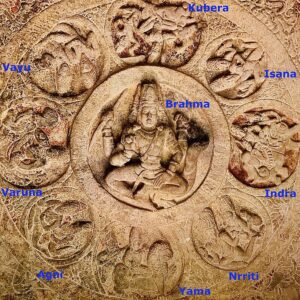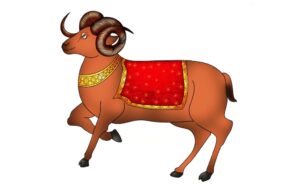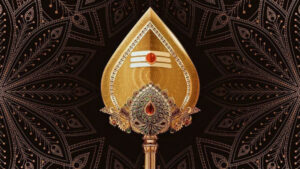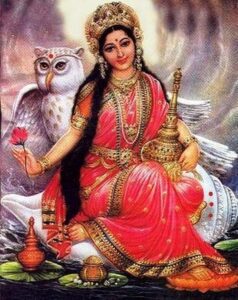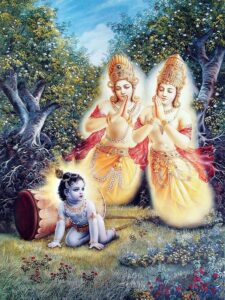Agni is the god of fire. Agni is one of the Dikapala and is the guardian deity of the Southeast direction. For the same reason, he is typically placed in the southeast corners of temples.
Agni is one of the Panch Mahabhuta (five inert impermanent elements) along with sky (Akasa), water (Apas / Jal), air (Vayu) and earth (Prithvi). Panch Mahabhuta form the empirically perceived material existence i.e. nature (Prakrti).
Agni is also famously known as:
• Pāvaka – sanctifier of everything;
• Havyavāhana – one who carries the sacrificial butter;
• Saptajihvi – one with seven tongues (flames); and consumes the sacrificial butter very fast;
• Vahni – travelling with wind;
• Anala – as one of the Vasus;
• Hutāśana – Consumer of the sacrificed;
• Chitrabhānu – colourful light;
• Jvalana – glowing;
• Vaiśvānara – the Man of the world;
• Vibhāvasu – whose light is wealth;
• Dhumaketu – one who is crowned with fire.
Other names include Śikhī, Pingesa, Plavanga, Bhūritejaḥ, Rudragarva and Hiraṇyakṛta.
Iconography

He is shown with one to three heads, and two to four arms. He is typically red-complexioned or smoky-grey-complexioned standing next to or riding a ram, with a dramatic halo of flames leaping upwards from his crown. He is shown as a strong-looking man, sometimes bearded, with a large belly because he eats everything offered into his flames, with golden brown hair, eyes and a moustache to match the colour of fire. His mount is a sheep.
Agni holds a rosary in one hand to symbolize his prayer-related role and a sphere in the other hand in the eastern states of India. In other regions, his four arms hold an axe, torch, spoon (or fan) and a flaming spear (or rosary).
Occasionally, Agni iconography is shown in Rohitasva form, which has no ram as his Vahana, but where he is pulled in a chariot with seven red horses, and the symbolic wind that makes fire move as the wheels of the chariot.
In Khmer art, Agni has been depicted with a rhinoceros as his Vahana.
Agni is a son of Kashyapa and Aditi as Aditya and a Pancha Bhuta. In the Vishnu Purana, Agni, called Abhimāni is said to have sprung from the mouth of the Virāta Puruṣa, the Cosmic Man, a form of Vishnu by Kashyapa and Aditi. In another version, Agni is born to Kashyapa and Aditi from the ritual fire produced by Dharma and Vasubhāryā.

According to the Puranic mythology, Agni married Svāhā (invocation offering) and fathered three sons – Pāvaka (purifier), Pāvamāna (purifying) and Śuchi (purity). From these sons, he has forty-five grandchildren which are symbolic names of different aspects of a fire. Also, Medhā (intelligence) is Agni’s sister. Agniloka is an abode of the god.
Role in Vedic Rituals
In Vedic rituals, Agni serves as a crucial intermediary between humans and the divine. He is considered the messenger who carries offerings to the gods and delivers their blessings back to the worshippers. The Agnihotra, a sacred fire ritual, exemplifies this role. Performed daily in many traditional Hindu households, this ritual involves offerings of ghee (clarified butter) and grains into the sacred fire, invoking Agni’s presence and favour. Agni is considered the mouth of the gods and goddesses and the medium that conveys offerings to them in a Homa (votive ritual).

Agni is not just a passive recipient of offerings but an active participant in the ritual process. The fire is seen as a living deity that consumes the offerings, transforming them into a divine essence that can be carried to the heavens. This ritual underscores Agni’s role as a purifying agent, capable of cleansing both physical substances and spiritual intentions.

Agni, the God of Fire, is a timeless symbol of transformation, purification, and divine communication in Hinduism. His role as a mediator between humans and the divine.




